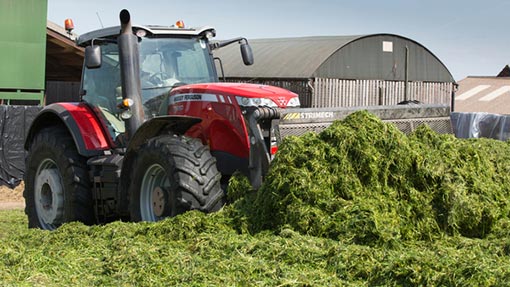Silage results confirm first-cut intake concerns

First cut grass silage quality is much poorer than that made in 2013, which could lead to reduced feed intakes and lower milk yields this winter.
Results from more than 5,000 first-cut and 1,500 second-cut samples analysed by Trouw Nutrition GB indicated dry matter is lower than that in 2012 and metabolisable energy (ME) is also reduced.
First-cut dry matter was 28.5% in comparison to 31.3% in 2012.
See also: Farmers must unite to win large-scale dairy battle
Speaking to Farmers Weekly at the UK Dairy Day, Telford, ruminant manager Adam Clay said this has been characterised by the mild winter and late turnout, which led to a highly fibrous plant.
Inconsistent weather during harvest further exacerbated the problem.
Although second cut quality is better than first cut (see table) largely due to better harvesting conditions.
Intakes reduced
Mr Clay said the biggest problem was reduced intake potential, which could threaten milk production – with intakes, on average, 12.9% lower than last year.
Consequently, he said the focus should be on stimulating forage intakes by increasing the palatability of silage.
Increasing concentrates may be a favourable option on the back of lower feed costs to help offset reduced production from forage, he added.
But he warned they must be carefully balanced to prevent acidosis risk, which is already high as a result of silages being wetter.
“If farmers need to increase concentrate supplementation to boost yields they are going to need to keep a suitable rumen environment because they’re adding more fermentable carbohydrates and that will reduce rumen pH, putting the rumen under pressure.”
He recommended using a blend of rapidly fermentable carbohydrates, which break down quickly in the rumen, in combination with slowly fermentable carbohydrates that break down in the small intestine – to reduce rumen pressure.
Acidosis risk
Lactic acid levels are higher at 66.9mg/kg for first cut.
But lactic acid levels in second-cut crops are significantly lower at 59.4%, so Mr Clay suggested mixing a drier second cut with a wetter first cut where possible to reduce risk of acidosis.
Mr Clay said farmers might need to consider using buffers to neutralise the high acid load and maintain optimum rumen pH.
Including structural fibre such as hay or straw in the diet can help slow rumen throughput.
But Mr Clay warned that it must be chopped to the correct length to prevent sorting.
Whole crop
The good news is that the 500 samples of wholecrop analysed well at 44.7% DM and 10.3 ME, which should compliment grass this winter and help drive yields.
“I would urge farmers to get forages analysed regularly and to take all steps to improve diet presentation and access to encourage cows to be keener feeders to help overcome potential intake problems.”
Comparison of 2013 and 2014 forages | ||||||
First-cut grass | Second-cut grass | Wholecrop | ||||
2014 | 2013 | 2014 | 2013 | 2014 | 2013 | |
Dry matter (%) | 28.5 | 33.2 | 33.9 | 34.7 | 44.7 | 38.6 |
pH | 3.9 | 4.0 | 4.0 | 4.1 | 4.0 | 4.2 |
VFAs (mg/kg) | 21.0 | 17.6 | 23.0 | 19.5 | ||
Lactic acid (mg/kg) | 66.9 | 58.1 | 59.4 | 48.6 | ||
Crude protein (%) | 13.0 | 13.6 | 13.4 | 13.9 | 8.3 | 9.9 |
D value | 65.6 | 67.5 | 66.3 | 65.7 | 66.0 | 64.7 |
NDF (%) | 49.8 | 46.7 | 46.5 | 46.9 | 38.8 | 48.2 |
Lignin (g/kg) | 35.9 | 39.5 | 35.4 | 40.8 | ||
ME (MJ/kg DM) | 10.5 | 10.8 | 10.6 | 10.5 | 10.3 | 10.1 |
Starch (%) | 24.1 | 19.6 | ||||
Intake (g/kgML) | 92.1 | 104.0 | 102.0 | 105.0 | 114.7 | 106.7 |
